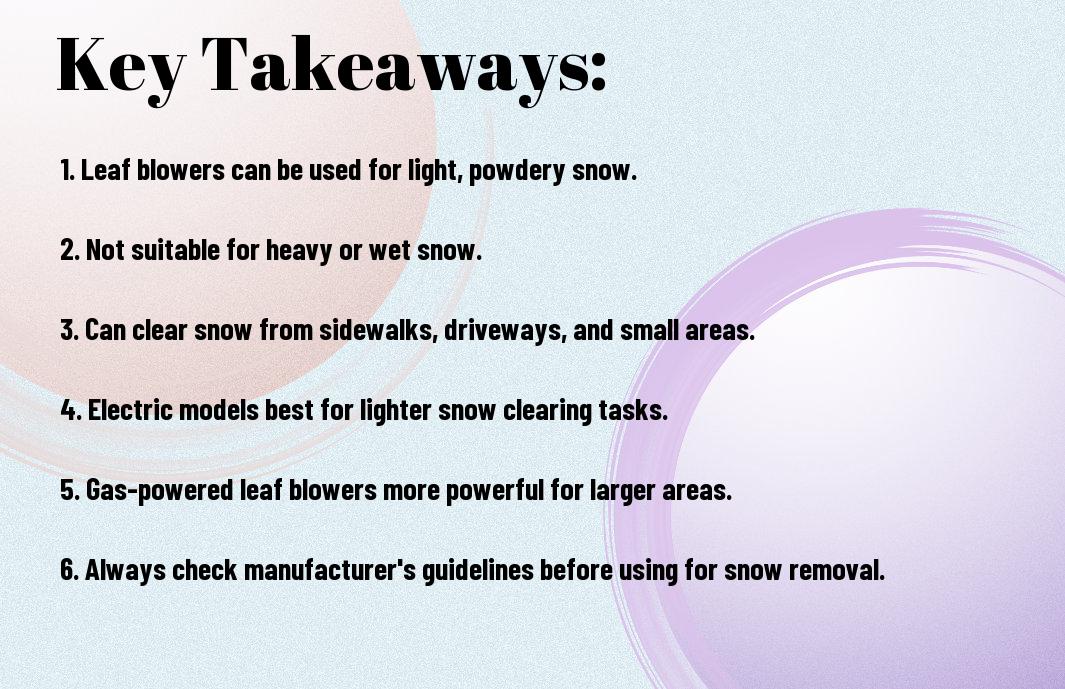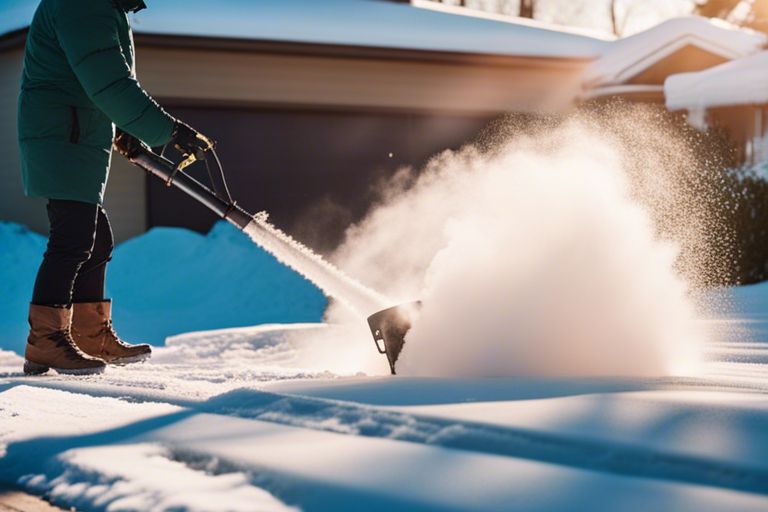With the winter season around the corner, many homeowners are looking for efficient ways to clear snow from their driveways and walkways. One question that often arises is whether a leaf blower can be used for snow removal. In this blog post, we will explore the effectiveness of using a leaf blower for clearing snow and provide tips for using this tool safely and efficiently during the winter months.
Key Takeaways:
- Leaf blowers are not designed for snow removal: Leaf blowers are typically not powerful enough to effectively remove heavy or packed snow from surfaces.
- Possible damage to the leaf blower: Using a leaf blower for snow removal can cause damage to the machine, as snow can clog the motor and other components.
- Consider snow-specific tools: It is recommended to use snow blowers, shovels, or other snow removal tools designed for the purpose to ensure efficient and safe removal of snow.

Understanding Leaf Blowers
Now let’s investigate into the world of leaf blowers to understand how they work and what makes them versatile tools for various outdoor tasks.
Types of Leaf Blowers
An important aspect of understanding leaf blowers is knowing the different types available in the market. Leaf blowers are broadly categorized into three types – handheld, backpack, and walk-behind. Each type has its own specific uses and advantages, making them suitable for different tasks. Perceiving the differences in these types will help you make an informed decision when choosing a leaf blower for your needs.
| Handheld | Lightweight and portable, suitable for small yards |
| Backpack | Provides more power and longer run times, ideal for larger properties |
| Walk-behind | Offers the most power and efficiency, best for heavy-duty tasks |
Power and Efficiency
Efficiency plays a crucial role in determining the performance of a leaf blower. Factors like engine power, airspeed, and airflow volume contribute to the efficiency of a leaf blower. Plus, the design and quality of the blower’s components also impact its overall efficiency and effectiveness in clearing leaves, debris, and even snow.
Leaf Blowers Versus Snow
Compatibility of Leaf Blowers with Snow
On the surface, using a leaf blower for snow might seem like a practical solution due to its powerful blowing capacity. However, using a leaf blower on snow requires careful consideration of the type of leaf blower and the density of the snow. Some leaf blowers may not be designed to handle the wet, heavy snow commonly found in colder climates, making them less effective for snow removal tasks.
Limitations of Using Leaf Blowers on Snow
Leaf blowers may struggle with packed snow or icy surfaces, as their blowing power may not be sufficient to move such dense material effectively. Additionally, using a leaf blower on snow can be challenging in windy conditions, as the snow may blow back into your face or onto areas you’ve already cleared, requiring additional effort to achieve a satisfactory result.
While leaf blowers can be a useful tool for clearing light, fluffy snow from driveways or walkways, they may not be the most efficient option for heavy or packed snow. It’s important to consider the specific conditions of the snowfall and the capabilities of your leaf blower before attempting to use it for snow removal tasks.
Versus
When comparing leaf blowers to dedicated snow blowers, the main difference lies in their design and functionality. Snow blowers are specifically designed to handle snow removal tasks, with features like augers and impellers to break up and throw snow efficiently. While leaf blowers can work in certain snow conditions, they may not provide the same level of effectiveness and convenience as a dedicated snow blower, especially for heavier or wetter snowfall.

Safety and Best Practices
Precautions When Using Leaf Blowers for Snow
To ensure safe operation when using leaf blowers for snow removal, there are important precautions to keep in mind. Firstly, always wear appropriate safety gear such as goggles, gloves, and sturdy footwear to protect yourself from snow and debris. Secondly, be mindful of your surroundings and avoid pointing the blower in the direction of others or towards windows to prevent any accidents.
Maintenance and Care
An vital aspect of using leaf blowers for snow is proper maintenance and care to ensure their efficiency and longevity. Regularly inspect the blower for any signs of wear and tear, such as frayed cords or damaged components, and promptly address any issues. Clean the blower after each use to remove any snow or debris that may have accumulated, preventing clogs and potential damage to the equipment.
Precautions When using leaf blowers for snow, remember to always consult the manufacturer’s guidelines and specifications for your specific model. Proper storage in a dry and secure location can also help prolong the life of your leaf blower and ensure it is ready for use when the next snowfall hits.
Alternatives to Leaf Blowers for Snow Removal
Traditional Snow Removal Tools
Removal of snow has traditionally been accomplished using simple tools like shovels, snow pushers, and snow blowers. While these tools may require physical exertion, they have been reliable for centuries in clearing snow from driveways, sidewalks, and walkways.
Innovations in Snow Removal Equipment
Snow removal technology has advanced significantly in recent years, offering innovative solutions for clearing snow more efficiently and effectively. From electric snow shovels to snow melting mats, there are now a variety of tools available to make snow removal less strenuous and more convenient.
Plus, the introduction of heated driveways and walkways has revolutionized snow removal by preventing snow and ice buildup altogether. These systems use radiant heat to melt snow as it falls, keeping surfaces clear and safe without the need for manual labor.

To wrap up
With these considerations in mind, it is clear that while leaf blowers can be used for light snow removal on smooth surfaces like driveways and walkways, they are not suitable for heavy or wet snow. Using a leaf blower for snow can save time and effort compared to shoveling, but it is important to prioritize safety and be mindful of the type of snow being cleared. Remember to follow manufacturer guidelines, wear appropriate protective gear, and always exercise caution when operating machinery in winter conditions. Overall, using a leaf blower for snow can be a convenient option, but it should be done with care and understanding of its limitations.
FAQ
Q: Can you use a leaf blower for snow?
A: Yes, you can use a leaf blower for snow. However, it is important to ensure that the leaf blower is capable of handling snow removal and has the necessary power to effectively clear snow from your desired area.
Q: What type of leaf blower is best for snow removal?
A: The best type of leaf blower for snow removal is a gas-powered backpack leaf blower with a high CFM (cubic feet per minute) and MPH (miles per hour) rating. These types of leaf blowers have the power needed to handle heavier snowfall.
Q: Is it safe to use a leaf blower for snow on all surfaces?
A: No, it is not safe to use a leaf blower for snow on all surfaces. Leaf blowers are best suited for flat, hard surfaces like driveways, sidewalks, and decks. Using a leaf blower on uneven or delicate surfaces can cause damage.
Q: Are there any precautions to take when using a leaf blower for snow?
A: Yes, there are precautions to take when using a leaf blower for snow. Wear appropriate safety gear such as safety goggles and ear protection, and be mindful of the direction in which you are blowing the snow to avoid injuring yourself or others.
Q: Can a leaf blower replace a traditional snow blower?
A: While a leaf blower can be used for light snow removal, it is not a direct replacement for a traditional snow blower. Snow blowers are specifically designed to handle larger amounts of snow and are more efficient for clearing driveways and walkways during heavy snowfall.
